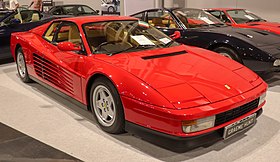
Back فيراري تيستاروسا Arabic Ferrari Testarossa Bulgarian Ferrari Testarossa Breton Ferrari Testarossa BS Ferrari Testarossa Czech Ferrari Testarossa German Ferrari Testarossa Spanish Ferrari Testarossa Basque فراری تستروزا Persian Ferrari Testarossa Finnish
| Ferrari Testarossa, 512 TR and F512 M | |
|---|---|
 | |
| Overview | |
| Manufacturer | Ferrari |
| Production | 1984–1996 (9,939 produced) |
| Assembly | Maranello, Italy |
| Designer | Diego Ottina, Leonardo Fioravanti, Ian Cameron, Guido Campoli, Emanuele Nicosia at Pininfarina (Testarossa)[1] Pietro Camardella at Pininfarina (512 TR) |
| Body and chassis | |
| Class | Sports car Grand tourer (S) |
| Body style | 2-door berlinetta |
| Layout | Rear mid-engine, rear-wheel-drive |
| Powertrain | |
| Engine | 4.9 L Tipo F113 flat-12 |
| Transmission | 5-speed manual |
| Chronology | |
| Predecessor | Ferrari 512 BBi |
The Ferrari Testarossa (Type F110) is a 12-cylinder mid-engine sports car manufactured by Ferrari, which went into production in 1984 as the successor to the Ferrari Berlinetta Boxer. The Pininfarina-designed car was originally produced from 1984 until 1991, with two model revisions following the end of Testarossa production called the 512 TR and F512 M, which were produced from 1992 until 1996. Including revised variations, almost 10,000 cars in total were produced, making it at the time one of the most mass-produced Ferrari models.[2]
The Testarossa is a two-door coupé that premiered at the 1984 Paris Auto Show.[3][4] All versions of the Testarossa were available with a rear-mounted, five-speed manual transmission. The rear mid-engine design (engine between the axles but behind the cabin) keeps the centre of gravity in the middle of the car, which increases stability and improves the car's cornering ability, and thus results in a standing weight distribution of 40% front: 60% rear.[5]
The original Testarossa was re-engineered for the 1992 model year and was introduced as the 512 TR (TR meaning TestaRossa), at the Los Angeles Auto Show, effectively as a completely new car,[2] and an improved weight distribution of 41% front, 59% rear.[6] Another new variant called the F512 M was introduced at the 1994 Paris Auto Show.[2] The car dropped the TR initials and added the M which in Italian stood for modificata, or translated to modified, and was the final version of the Testarossa,[2][3] which continued its predecessor's weight distribution improvement of 42% front, 58% rear. The F512 M was Ferrari's last vehicle that featured the flat-12 engine.
The Testarossa is a recognized cultural icon of the 1980s, and was popularized by media including the 1984 television series Miami Vice (from the 1986 season onward) and Sega's 1986 video game Out Run.
- ^ "Testarossa Development". red-headed.com. Retrieved 12 July 2019.
- ^ a b c d Auto Editors of Consumer Guide. "Ferrari Testarossa". How Stuff Works. Archived from the original on 14 June 2007. Retrieved 3 January 2009.
- ^ a b Cite error: The named reference
testarossawas invoked but never defined (see the help page). - ^ Cite error: The named reference
ferraritestarossawas invoked but never defined (see the help page). - ^ "Carfolio: Ferrari Testarossa". Carfolio. Retrieved 2 January 2009.
- ^ "Carfolio: Ferrari 512 TR". Carfolio. Retrieved 3 January 2009.